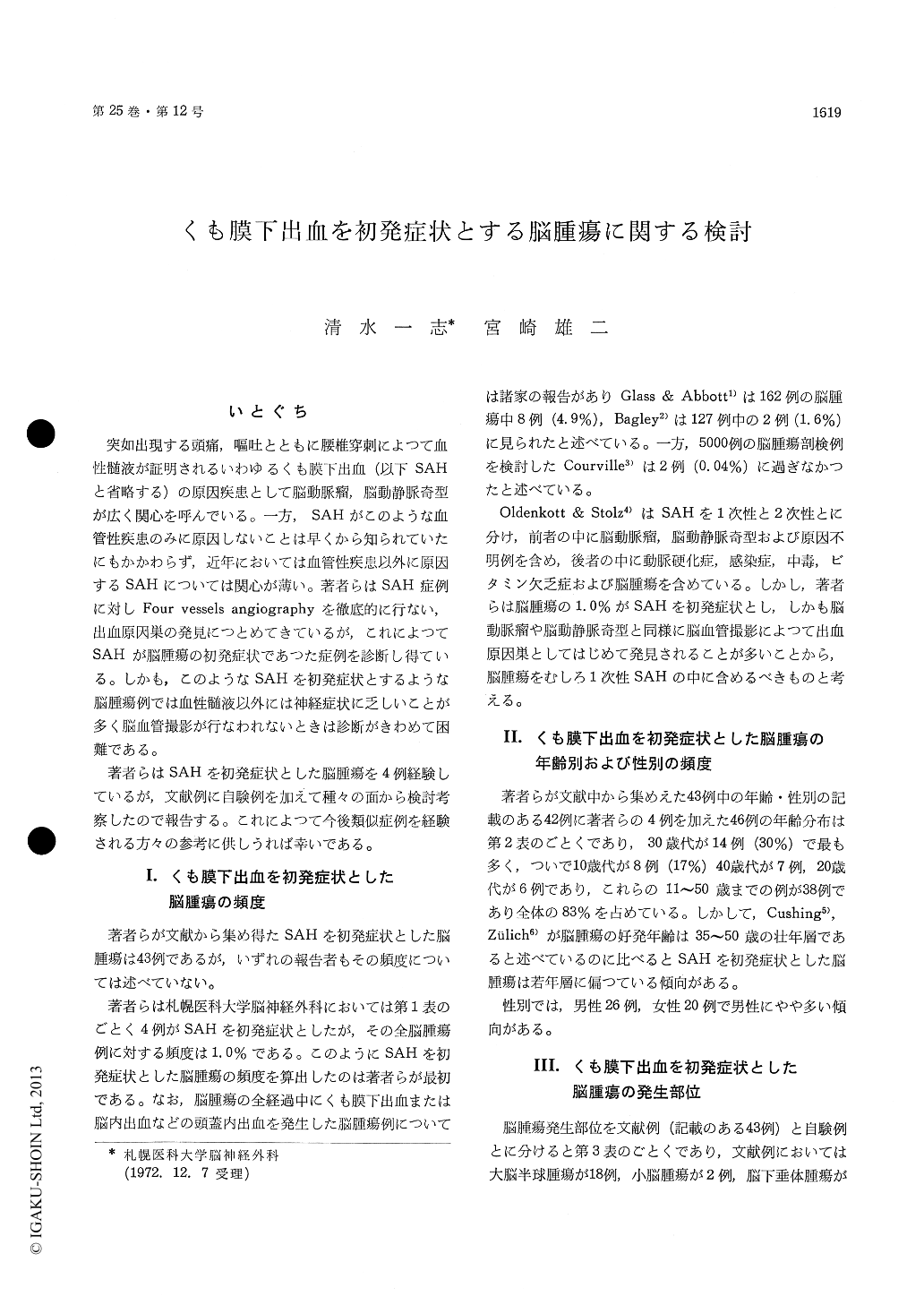Japanese
English
- 有料閲覧
- Abstract 文献概要
- 1ページ目 Look Inside
いとぐち
突如出現する頭痛,嘔吐とともに腰椎穿刺によつて血性髄液が証明されるいわゆるくも膜下出血(以下SAHと省略する)の原因疾患として脳動脈瘤,脳動静脈奇型が広く関心を呼んでいる。一方,SAHがこのような血管性疾患のみに原因しないことは早くから知られていたにもかかわらず,近年においては血管性疾患以外に原因するSAHについては関心が薄い。著者らはSAH症例に対しFour vessels angiographyを徹底的に行ない,出血原因巣の発見につとあてきているが,これによつてSAHが脳腫瘍の初発症状であつた症例を診断し得ている。しかも,このようなSAHを初発症状とするような脳腫瘍例では血性髄液以外には神経症状に乏しいことが多く脳血管撮影が行なわれないときは診断がきわめて困難である。
著者らはSAHを初発症状とした脳腫瘍を4例経験しているが,文献例に自験例を加えて種々の面から検討考察したので報告する。これによつて今後類似症例を経験される方々の参考に供しうれば幸いである。
As the causal disease of subarachnoid hemor-rhage, intracranial aneurysm and arteriovenous malformation have been receiving wide attention. On the other hand, while it has been known that the etiology of subarachnoid hemorrhage lies in causal disease, in recent years little attention has been paid to subarachnoid hemorrhage caused by disease other than intracranial vascular disease.
The authors have conducted a four vessels angio-graphy investigation on the case of subarachnoid hemorrhage with the intent of pinpointing the true cause. As a result, 4 cases with subarachnoid hemorrhage as the initial symptom of intracranialtumor were encountered, and 43 similar cases available in the literature from various angles.
The frequency of incidence of intracranial tumors having subarachnoid hemorrhage as their initial symptom is approximately 1.0% of all intracranial tumors. The sites of the tumors in the supra-tentrial space are the frontal lobe, the intraventri-cular and occipital lobe and it may be noted that these tumors arise in sites where focal symptoms can hardly be seen, moreover, it is noted that the size of the tumor in the cerebral hemisphere ex-ceeds walnut size. It is also noted that in supra-tentorial tumors, pituitary tumors also show sub-arachnoid hemorrhage as the initial symptom. On the other hand, when the site of the tumor is in the cerebellar vermis adjacent to subarachnoid cistern, subarachnoid hemorrhage is seen as the initial symptom in spite of the tumor being a subtentorial space. According to the histological classification of brain tumors, those with an abund-ance of vascularity have a tendency to show sub-arachnoid hemorrhage as the initial symptom with the largest number of cases seen in gliomas follow-ed by meningioma, pituitary adenoma and choroid plexus papiloma.
Brain tumor with the initial symptom as sub-arachnoid hemorrhage may be divided into 5 typesin accordance with their clinical courses.
Type I: A rapid course leading to death by the onset of subarachnoid hemorrhage.
Type II: Following subarachnoid hemorrhage a temporary critical state is seen, this im- proves and no neurological symptoms are seen.
Type III: Following subarachnoid hemorrhage and after recovery from a critical state a gradual appearance of symptom of brain tumor is seen.
Type IV : Cases in which both the onset of sub- arachnoid hemorrhage and symptoms of brain tumor are seen together.
Type V : Cases in which subarachnoid hemor- rhage is repeated and a gradual appearance of brain tumor are seen.
With knowledge that brain tumors with sub-arachnoid hemorrhage as their initial symptom exist in mind, various investigations were conduct-ed on subarachnoid hemorrhage cases, at the same time it must be kept in mind that while there are brain tumors with a gradual course, there are also cases with a rapid course of events leading to death.

Copyright © 1973, Igaku-Shoin Ltd. All rights reserved.


